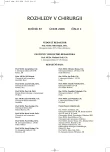Rupture of the Interventricular Septum after the Blunt Trauma of Thorax
Authors:
K. Šmejkal; R. Pařízková *; J. Harrer **; A. Lukeš ***; J. Koudelka ****; I. Žvák
Authors‘ workplace:
Katedra válečné chirurgie, Fakulta vojenského zdravotnictví UO, Hradec Králové, vedoucí katedry
doc. MUDr. A. Ferko, CSc.
Katedra válečné chirurgie, Fakulta vojenského zdravotnictví UO, Hradec Králové, vedoucí katedry
Chirurgická klinika, Fakultní nemocni
; Katedra válečné chirurgie, Fakulta vojenského zdravotnictví UO, Hradec Králové, vedoucí katedry
Klinika anesteziologie, resuscitace a intenzivní medicíny, Fakultní nemocnice Hradec Králové
Katedra válečné chirurgie, Fakulta vojenského zdravotnictví UO, Hr
*; Katedra válečné chirurgie, Fakulta vojenského zdravotnictví UO, Hradec Králové, vedoucí katedry
Kardiochirurgická klinika, Fakultní nemocnice Hradec Králové, přednosta: doc. MUDr. J. Harrer, CSc.
**; Katedra válečné chirurgie, Fakulta vojenského zdravotnictví UO, Hradec Králové, vedoucí katedry
Dětská klinika, Fakultní nemocnice Hradec Králové, přednosta: doc. MUDr. E. Pařízková, CSc.
***; Katedra válečné chirurgie, Fakulta vojenského zdravotnictví UO, Hradec Králové, vedoucí katedry
Oddělení dětské chirurgie a traumatologie, Fakultní nemocnice Hradec Králové
Katedra válečné chirurgie, Fakulta vojenského zdravotnictví UO, Hradec Králové, ve
****
Published in:
Rozhl. Chir., 2008, roč. 87, č. 2, s. 76-79.
Category:
Monothematic special - Original
Overview
Authors present the case of little patient with the dissection, pseudoaneurysm and finally a rupture of the interventricular septum after the blunt thracic injury. The patient was smitten as a pedestrian by a car and during the whole period of her stay in the hospital she was showing signs of circulatory instability. Due to the current intraabdominal injuries this circulatory decompensation was first assigned to hemoperitoneum, for which the girl was operated on about 3 hours after admission. Nevertheless, even after the abdminal cavity check, after the treatment of supreficial liver lacerations and intensive volume resuscitation the patient showed signs of insufficiency. Diagnosis was finally determined on the base of the transthoracic echocardiography (TTE), which proved the traumatic rupture of interventricular septum. The operation followed correcting the defect, which was performed with a good result according to the TTE postoperatively. Nevertheless, 27 hours after the admission the patient died due to the electromechanical dissociation. In the discussion the authors then evoke a number of papers concerning the same topic.
Key words:
blunt thoracic injury – interventricular septal rupture
Sources
1. Heweet, P. Rupture of the heart and large vessels: the result of injuries. Lond. Med. Gaz., 1847, Vol. 1, p. 870.
2. Masselli, D., Micalizzi, E., Pizio, R., et al. Posttraumatic Left Ventricular Pseudoaneurysm Due to Intramyocardial Dissecting Hematoma. Ann. Thorac. Surg., 1997, Vol. 64, No. 3, p. 830–831.
3. Stamm, Ch., Lloyd, R., Geva, T., et al. Repair of ventricular septal defect and left ventricular aneurysm following blunt chest trauma. Eur. J. Cardiothorac. Surg., 2002, Vol. 22, No. 1, p. 154–156.
4. Genomi, M., Jenni, R., Turina, M. Traumatic ventricular septal defect. Heart, 1997, Vol. 78, p. 316–318.
5. Gündogdu, F., Gurlertop, Y., Arslan, S., et al. Ventricular Septal Rupture and Mitral Regurgitation Caused by Trauma. Echocardiography, 2007, Vol. 24, No. 2, p. 174–175.
6. Mello, R. P., Santana, M. V., Silva, M. A., et al. Ventricular septal rupture following blunt chest trauma. Arq Bras Cardiol, 2006, Vol. 87, No. 6.
7. Cowgill, L. D., Campbell, D. N., Clarke, D. R., et al. Ventricular septal defect due to nonpenetrating chest trauma: use of intra-aortic balloon pump. J. Trauma, 1987, Vol. 27, p. 1087–1090.
8. Danzl, D. F., Thomas, D. M., Miller, J. W., et al. Ventricular septal defect following blunt chest trauma. Ann Emerg Med, 1980, Vol. 9, p. 150–154.
9. Silverstein, J. R., Tasset, M. R., Dowling, R. D., et al. Traumatic Intramyocardial Left Ventricular Dissection: A Case Report. J. Am. Soc. Echocardiography, 2006, Vol. 19, No. 12, p. 1529–1532.
10. Moront, M., Lefrak, E. A., Akl, B. F. Traumatic rupture of the interventricular septum and tricuspidal valve: case report. J. Trauma, 1991, vol. 31, p. 134–136.
11. Kadner, A., Fasnacht, M., Kretchschmar, O., et al. Traumatic free wall and ventricular septal rupture – hybrid management in a child. Eur. J. Cardiothorac. Surg., 2007, vol. 31, no. 5, p. 949–951.
12. Rotman, M., Peter, R. H., Sealy, W. C., et al. Traumatic ventricular septal defect secondary to nonpenetrating chest trauma. Am. J. Med., 1970, Vol. 48, p. 127–131.
13. Rollins, M. D., Koehler, M. D., Stevens, M. D., et al. Traumatic Ventricular Septal Defect: Case Report and Review of the English Literature since 1970. J. Trauma, 2005, Vol. 58, p. 175–180.
Labels
Surgery Orthopaedics Trauma surgeryArticle was published in
Perspectives in Surgery

2008 Issue 2
- Metamizole vs. Tramadol in Postoperative Analgesia
- Obstacle Called Vasospasm: Which Solution Is Most Effective in Microsurgery and How to Pharmacologically Assist It?
- Current Insights into the Antispasmodic and Analgesic Effects of Metamizole on the Gastrointestinal Tract
- Spasmolytic Effect of Metamizole
Most read in this issue
- „Tension Free“ Method in Inguinal Hernioplasty Using CHS 100 Mesh – Our Experience
- Benefits of Intraoperative N. Laryngeus Recurrens Neuromonitoring in Thyroid Surgery
- Spontaneous Rupture of Ductus Choledochus in Acute Pancreatitis – a Case Report
- Surgical Management of Proximal Humeral Fractures Using the Hackethal (Zifko) Method – A Case Review
